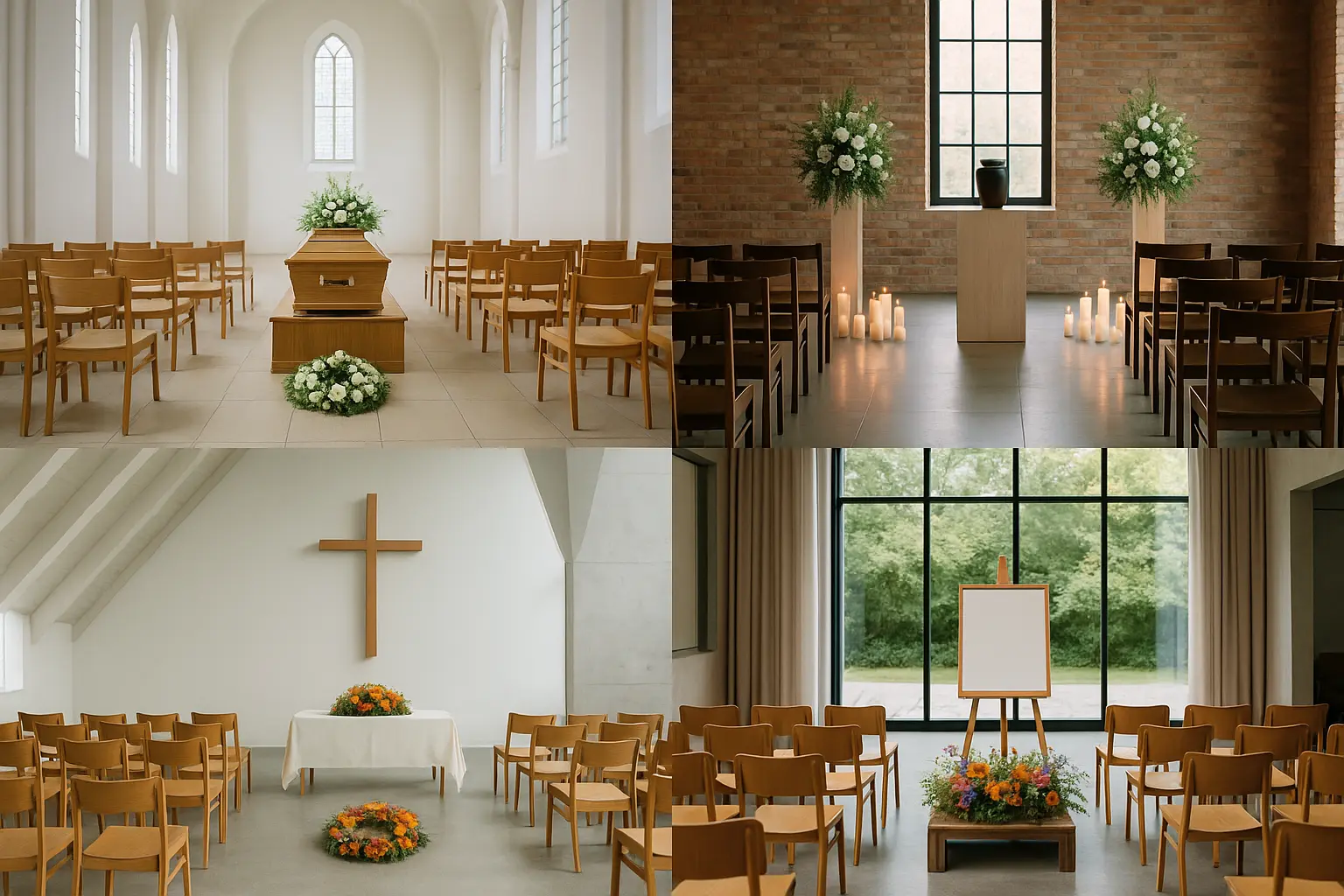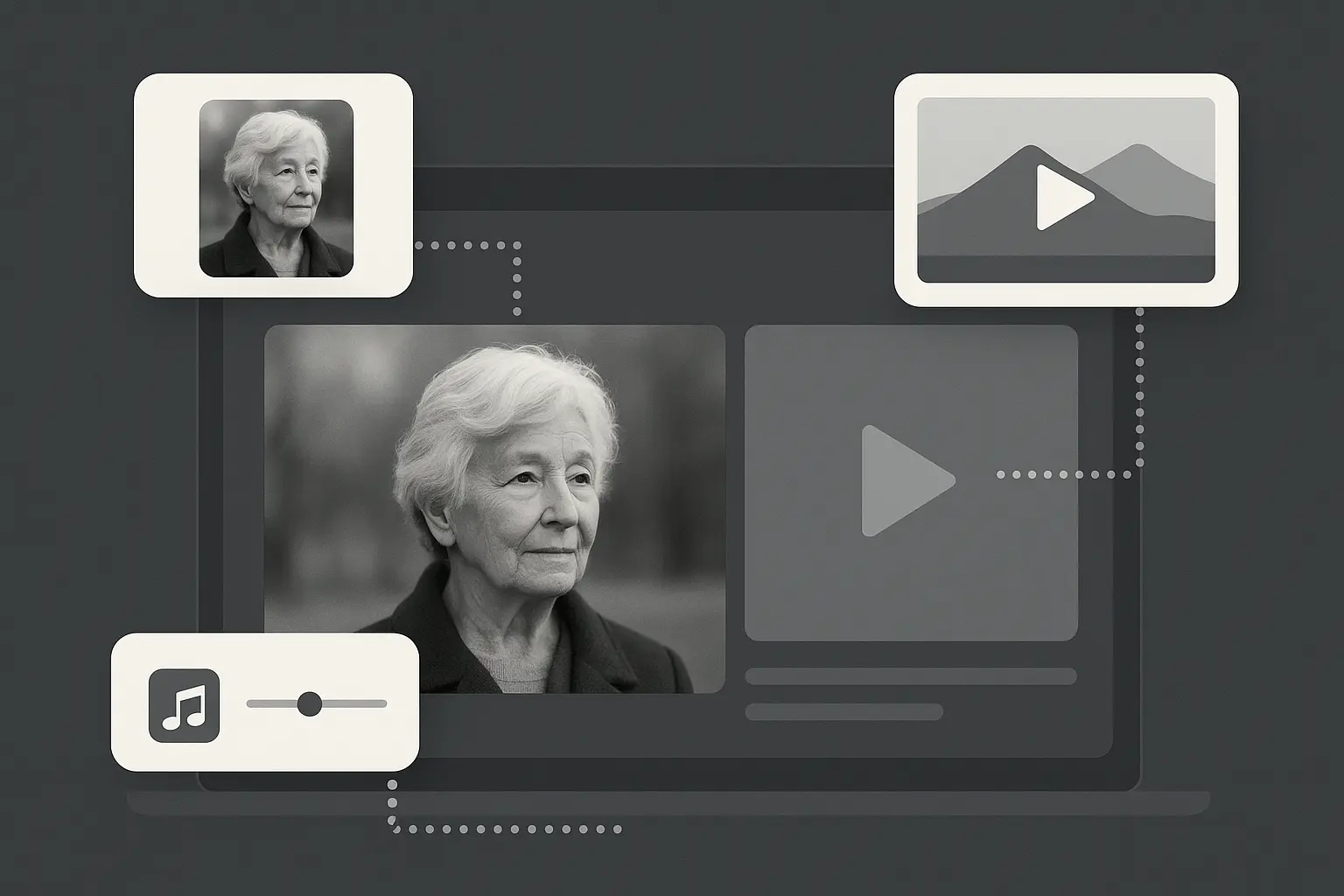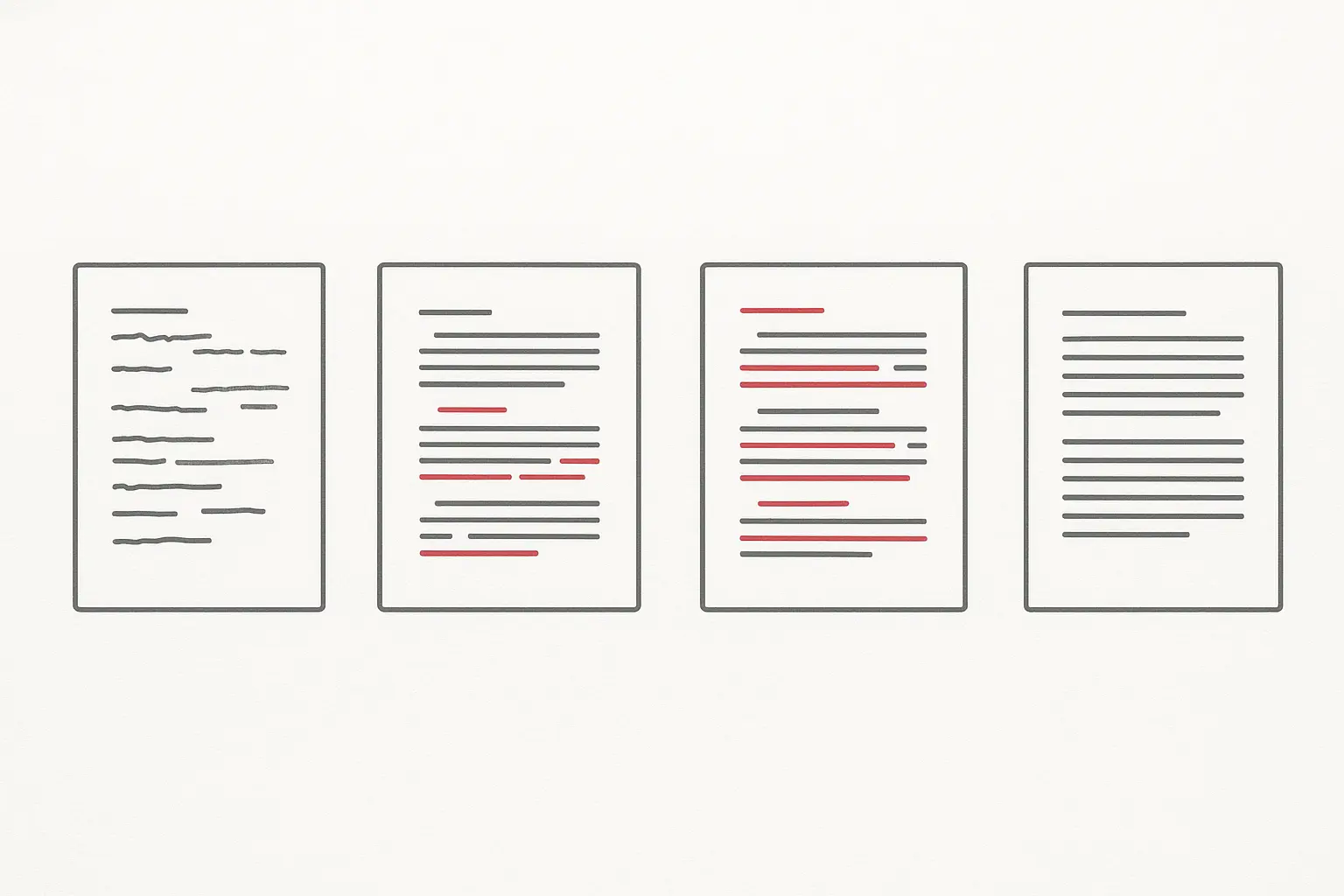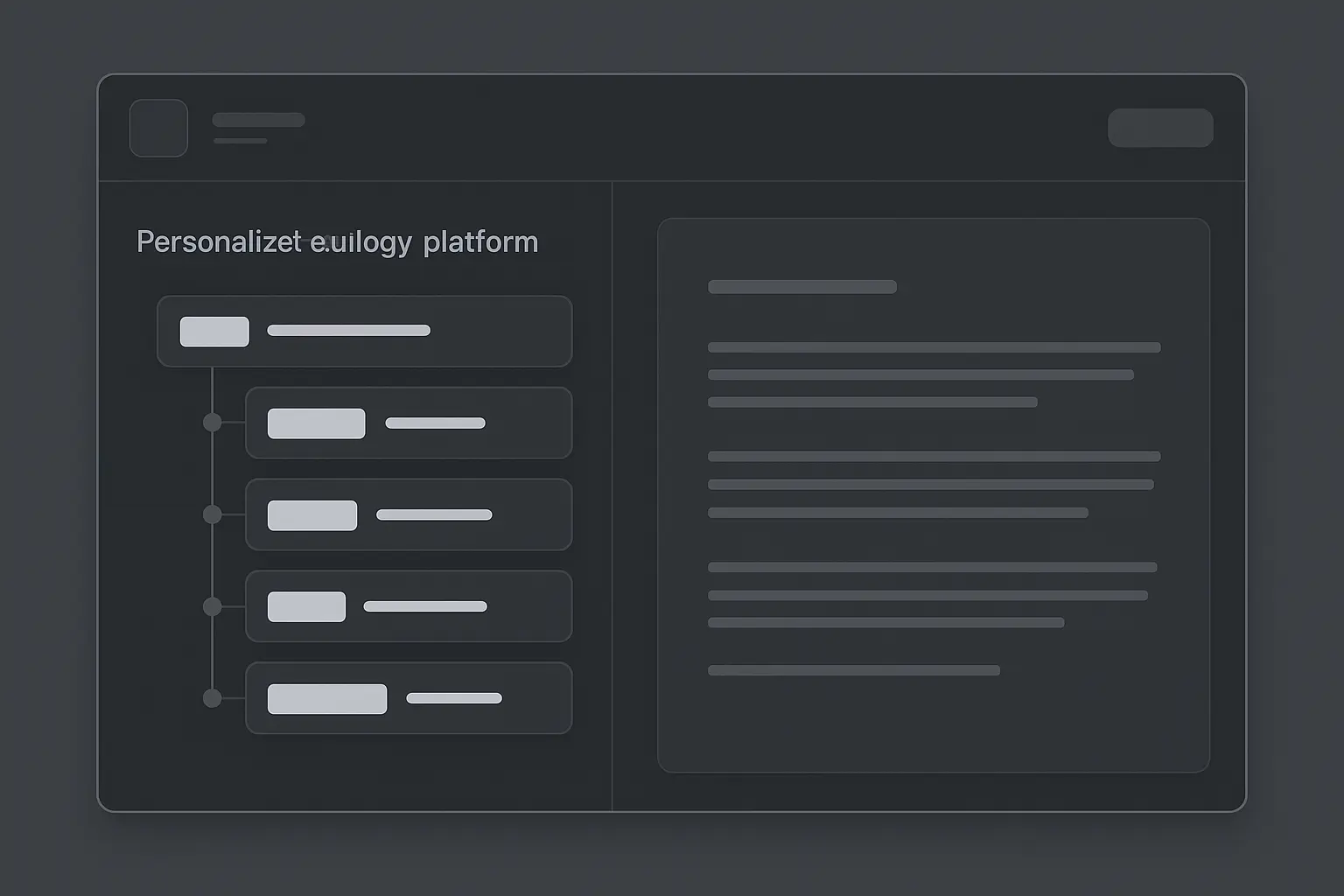
When I had to write my first eulogy, I went straight to Google like everyone else. Big mistake. What I found were these awful fill-in-the-blank templates that made honoring my dad feel like filling out a DMV form. The good news? Eulogy templates have changed dramatically since then. Modern templates actually get it – every person is different, every relationship is unique, and cookie-cutter approaches don’t work when you’re trying to capture someone’s essence.
Quick Resource:
Create a heartfelt, personalized tribute using the Eulogy Generator — a modern tool that transforms overwhelming moments into meaningful words.
After helping hundreds of families through this process, I’ve learned that the best templates don’t just give you structure. They help you find your voice and tell the story that matters.
TL;DR
- Modern eulogy templates have evolved from rigid fill-in-the-blank formats to flexible frameworks that adapt to your personal relationship and speaking style
- Digital platforms now offer interactive tools that guide you through personalized eulogy creation rather than just providing static templates
- Specialized templates exist for different relationships, loss circumstances, and cultural considerations – you don’t have to force a generic approach
- The best templates include emotional support features and grief-aware prompts that help you process memories without becoming overwhelmed
- AI-powered enhancement can suggest improvements and fill content gaps while preserving your authentic voice and personal memories
- Template selection should be based on your relationship to the deceased, audience expectations, and ceremony requirements rather than just picking the first option you find
Why Old Templates Sucked (And What’s Different Now)
Remember those templates that went: birth, school, job, marriage, kids, death? Yeah, those. They turned every tribute into a LinkedIn profile reading. I’ve seen countless families struggle with these rigid formats that missed something fundamental about how to write a eulogy – every relationship is unique, and every loss deserves an authentic tribute.

Here’s what was wrong with that approach:
- It assumed everyone had the same life path
- It ignored what made the person special
- It felt like reading a resume, not honoring a human being
- It forced your loved one’s story into a predetermined mold
Today’s templates work backwards from your relationship. Instead of asking “What did they accomplish?” they ask “What’s a moment when you really saw who they were?” That shift changes everything.
Skip the generic outlines. Craft something authentic with the Eulogy Generator.
For those seeking specific guidance, our comprehensive eulogy writing guide offers detailed strategies for creating meaningful tributes that go beyond basic template structures.
How Contemporary Templates Actually Work
Modern eulogy templates function more like guided conversations than rigid outlines. They recognize that your relationship with your grandmother will require a completely different approach than honoring a colleague or childhood friend. Instead of forcing you into a rigid structure, these templates adapt to your responses and help you discover the natural narrative that emerges from your shared experiences.
What makes these templates particularly effective is their focus on storytelling rather than fact-listing. They help you identify the themes that defined your loved one’s life, the moments that captured their essence, and the impact they had on others. This approach creates eulogies that feel alive and personal rather than biographical summaries.
The difference becomes clear when you see them side by side. Traditional approaches might ask “What were their major accomplishments?” while contemporary templates ask “What’s a moment when you saw their true character shine through?” The second question leads to much more engaging and meaningful content for your eulogy funeral.
Discover how storytelling transforms tributes with the Eulogy Generator.
Finding Templates That Match Your Situation
Not all relationships are the same, and your template shouldn’t pretend they are. Different relationships call for distinctly different approaches to eulogy writing, and the best templates recognize these nuances.

For spouses: You can get personal. Share the daily moments, the inside jokes, the dreams you built together. These eulogies can include intimate details that wouldn’t be appropriate in other contexts.
For friends: Focus on adventures, conversations that mattered, how they influenced your life. Friend eulogies often work best when they highlight specific shared experiences and character observations.
For colleagues: Highlight their professional impact while keeping appropriate boundaries. These tributes typically emphasize achievements and contributions to the workplace community.
For parents: Think about lessons learned, values passed down, the legacy they’re leaving. Parent eulogies often trace the evolution of your relationship over time.
Whether you’re honoring a family member or friend, our specialized friend eulogy templates provide frameworks designed specifically for non-family relationships and their unique dynamics.
The ceremony matters too. A celebration of life calls for a different approach than a traditional funeral service. Eulogy funeral contexts create different expectations for content and tone.
Choose a framework that fits your service perfectly with the Eulogy Generator.
Cultural and Religious Considerations
Effective template selection must account for cultural traditions and religious practices that were important to your loved one or their family. Some cultures emphasize community storytelling, where multiple voices contribute to the eulogy. Templates for these situations need to accommodate shared speaking time and provide smooth transitions between different speakers.
Religious considerations can affect everything from the language you use to the themes you emphasize. Some faiths focus heavily on eternal life and reunion, while others emphasize the person’s earthly contributions and legacy. The best templates provide guidance on incorporating these elements naturally without making the funeral service program feel forced or inauthentic.
What Makes Modern Templates Actually Helpful
The best templates today include features that go far beyond basic structural guidance. They recognize that eulogy writing is both an emotional and practical challenge, requiring support for grief processing, delivery preparation, and audience engagement.

Emotional support: They acknowledge that writing while grieving is hard. They include gentle prompts that help you access memories without getting overwhelmed. Grief-aware writing prompts are carefully crafted to help you build your eulogy piece by piece without becoming emotionally flooded.
Cultural awareness: They can adapt to different religious traditions and cultural practices without feeling forced. This includes guidance on incorporating meaningful elements respectfully.
Flexibility: They give you options for different speaking styles – whether you’re a natural storyteller or prefer a more structured approach. Your natural speaking style should shine through any template you choose.
Real examples: They show you how others have successfully used similar frameworks, so you’re not starting from scratch. Reading eulogy examples can spark ideas for your own tribute and help you understand how to adapt template structures.
Get gentle, grief-aware prompts through the Eulogy Generator.
According to professional eulogy resources, at WordLayouts, we understand how hard it can be finding the right words to express yourself in times of grief, which is why modern templates are designed with emotional support features that guide users through the difficult process of memory collection and organization while managing grief.
Specialized Templates for Different Loss Circumstances
Different deaths create different emotional needs, and templates are increasingly recognizing that various circumstances require different approaches. Sudden loss templates help speakers navigate the unique challenges of unexpected deaths, focusing more on character celebration and impact rather than trying to make sense of timing or circumstances.
Celebration of life templates are designed for less formal memorial services that emphasize joy and community participation. These frameworks encourage storytelling, audience interaction, and lighter moments while still maintaining appropriate reverence.
For those dealing with unexpected loss, our guide on crafting a heartfelt eulogy for sudden loss provides specialized support for navigating the unique challenges of these circumstances.
The Writing Process That Actually Works
Successfully transforming a template into an authentic, personal eulogy requires a systematic approach that moves from memory collection through multiple revision cycles. This isn’t about filling in blanks – it’s about using the template’s structure to discover and organize the most meaningful aspects of your relationship with your loved one.

As grief counselors note, “take deep breaths. Close your eyes and take deep breaths. This will allow your mind to relax and roam through the different memories you have of your loved one,” emphasizing the importance of emotional preparation before beginning the writing process.
Here’s what I’ve seen work best:
1. Collect memories first – Talk to family and friends. Look through photos. Don’t worry about organizing yet. Start by talking with other family members and friends who knew your loved one well. They might remember stories you’ve forgotten or provide different perspectives on shared experiences.
2. Find the themes – What patterns emerge? Were they funny, generous, determined? These become your structure. Organize these memories thematically rather than chronologically. What themes emerge when you think about your loved one’s life?
3. Pick your best stories – Choose moments that show their character, not just list their achievements. Don’t worry about having too much material initially. It’s easier to edit down from abundance than to struggle with too little content.
4. Write like you talk – Don’t try to sound like someone else. Your natural voice is what people need to hear. The key is finding a template that feels natural to your voice rather than forcing you to adopt an unfamiliar persona.
5. Practice out loud – This isn’t just about memorizing. Reading aloud helps you catch awkward phrasing and adjust the flow. Most eulogies work best when they’re between 3-7 minutes long.
Memory Collection Strategies
Before you can effectively use any template, you need to gather the raw material – the memories, stories, and observations that will form the heart of your eulogy. This collection process works best when it’s systematic rather than random.
Look through photos, letters, or social media posts that might trigger additional memories. Organize these memories thematically rather than chronologically. Don’t worry about having too much material initially – most templates provide guidance on selecting the most impactful stories and observations from your collected memories.
For those seeking inspiration during the writing process, our collection of funny eulogy examples demonstrates how humor can be incorporated respectfully into meaningful tributes.
When Technology Helps (And When It Doesn’t)
AI isn’t replacing the human heart of eulogy writing – it’s making the process less overwhelming when you’re already dealing with grief. Think about it: you’re mourning someone you love, and suddenly you’re supposed to become a professional writer and public speaker? That’s where AI actually helps.

What AI does well:
- Asks the right follow-up questions when you’re stuck
- Suggests better ways to phrase something without changing your meaning
- Helps organize scattered thoughts into a coherent flow
- Fills in structural gaps you might miss while grieving
What AI can’t do:
- Remember your inside jokes
- Capture your loved one’s laugh
- Know what moment really mattered to your relationship
The best AI-powered platforms work like having a writing coach who asks good questions and helps you find your own words. They don’t write your eulogy – they help you write it better.
Let the Eulogy Generator guide you step-by-step — no writing experience required.
Digital Resources and Interactive Tools
Modern online template collections go far beyond basic formats. They’re organized by relationship type, cultural considerations, religious traditions, and ceremony styles. You can find templates specifically designed for honoring parents, spouses, friends, colleagues, or even beloved pets.
Interactive eulogy platforms represent the next evolution in template technology. Instead of presenting you with a static outline to fill in, these tools ask targeted questions that help build your eulogy organically. They might ask about your favorite memory with the person, what made them laugh, or how they showed love to others.
These platforms also help with the practical aspects of eulogy writing. They can estimate speaking time based on your content length, suggest transitions between different sections, and even provide tips for managing emotions during delivery.
To see how templates translate into actual speeches, explore our collection of eulogy examples that demonstrate various approaches and styles for different relationships and circumstances.
Specialized Templates for Different Types of Loss
Different circumstances require different approaches, and modern templates recognize this reality. The emotional needs of sudden loss are completely different from those of anticipated death after a long illness.
Sudden loss templates help speakers navigate the unique challenges of unexpected deaths. These frameworks acknowledge the shock and disbelief that often accompany sudden losses and provide structure when traditional approaches feel inadequate. They often focus more on character celebration and impact rather than trying to make sense of timing or circumstances.
Celebration of life templates are designed for less formal memorial services that emphasize joy and community participation. These frameworks encourage storytelling, audience interaction, and lighter moments while still maintaining appropriate reverence for the deceased.
Traditional funeral templates work within the constraints of formal religious or secular services, providing structure that respects ceremony requirements while still allowing for personal expression.
There are even specialized templates for pet memorials, recognizing that the bonds between humans and their animal companions deserve dignified recognition. These templates help speakers honor these relationships without feeling awkward about the depth of their grief.
Professional eulogy writers emphasize that delivering eulogies is among the most important work they do, noting that clergy often deliver “at least one eulogy a week,” highlighting the expertise that technology platforms can now make accessible to families who need to write their own tributes.
How AI is Changing Template Creation
Artificial intelligence is revolutionizing how eulogy templates function, offering personalized assistance that adapts to your specific situation while preserving authentic human emotion. These technological advances don’t replace the personal aspects of eulogy writing – instead, they enhance your ability to create meaningful tributes.
Advanced AI systems can analyze the information you provide about your loved one and suggest relevant memories, appropriate quotes, and structural improvements that enhance your eulogy’s quality. These systems don’t write your eulogy for you – they help you refine and improve what you’ve already created.
AI-powered platforms can identify gaps in your content and suggest areas where additional details might strengthen your tribute. They might notice that you’ve focused heavily on professional achievements but haven’t included much about personal relationships, prompting you to consider adding more intimate memories.
These systems can also help with language refinement, suggesting clearer phrasing or more impactful word choices while preserving your authentic voice. They’re particularly helpful for people who struggle with writing or feel uncertain about their ability to express their emotions effectively.
Multimedia Integration Capabilities
Modern templates can seamlessly incorporate photos, videos, music, and other media elements that enhance your spoken words. This multimedia approach creates richer, more engaging tributes that can help audience members connect with memories and emotions in multiple ways.
Visual storytelling elements might include photo slideshows that play during specific sections of your eulogy, or video clips that capture your loved one’s voice and personality. These elements can be particularly powerful when words alone feel insufficient to capture someone’s essence.
Some advanced platforms even enable creation of digital memorial spaces where your eulogy content becomes part of ongoing family history preservation. This integration transforms a traditional funeral speech into a multimedia experience that engages multiple senses and creates lasting digital memorials.
Choosing the Right Template for Your Situation
Here’s the honest truth: most people overthink this decision. You don’t need the “perfect” template. You need one that doesn’t fight against your natural way of expressing yourself.

Quick gut check:
- Do you tell stories naturally? Look for narrative-based templates
- More comfortable with structured thinking? Choose organized, point-by-point formats
- Tend to process emotions through humor? Find templates that show you how to include lightness respectfully
Consider your audience too:
- Small family gathering = more personal stories are fine
- Large mixed crowd = focus on universally relatable memories
- Religious service = incorporate appropriate spiritual elements
- Celebration of life = lean toward joyful, uplifting content
Don’t stress about making the wrong choice. Any decent template can be adapted once you start writing.
Assessment Strategies for Template Selection
Effective template selection begins with understanding your own needs and limitations. Consider how comfortable you are with public speaking – if you’re naturally nervous, you might benefit from templates that provide more detailed guidance and structure. If you’re an experienced speaker, you might prefer frameworks that offer more flexibility and creative freedom.
Think about your relationship with the deceased and what aspects of their life you’re best positioned to share. A spouse can speak to intimate daily moments and shared dreams. A colleague might focus on professional achievements and workplace relationships. A childhood friend could emphasize formative experiences and long-term character observations.
For specific relationship guidance, our spouse eulogy templates offer frameworks tailored to the unique dynamics and intimate nature of marital relationships.
Matching Templates to Ceremony Requirements
Different types of memorial services have different expectations and constraints that should influence your template choice. Traditional funeral services often have specific time limits and formal tones that require structured, efficient templates. Celebration of life gatherings might allow for more creative, interactive approaches.
Religious services may require templates that incorporate appropriate spiritual elements and respectful language. Some faiths have specific traditions or prayers that should be included, while others focus more on personal testimony and shared memories.
Consider practical constraints as well. If you’re speaking at a large service with many other speakers, you might need a shorter template that makes its impact quickly. If you’re the primary speaker at a smaller gathering, you might have more time to develop themes and share detailed stories.
The eulogy funeral context shapes everything from your word choice to your emotional approach. Eulogy examples that work beautifully at intimate family gatherings might feel inappropriate at formal religious services, and vice versa.
From Template to Personal Tribute: The Real Work
Templates give you the skeleton. Your memories provide the heart. Here’s how to bridge that gap:
Start messy: Write down everything you remember, even if it seems random. That story about them burning dinner, their terrible singing voice, how they always knew when you needed a hug – get it all down first.
Find your thread: Look for the common theme in your memories. Were they always helping others? Did they find joy in simple things? Were they the family problem-solver? That’s your through-line.
Pick your moments: Choose 2-3 specific stories that show this theme in action. Concrete moments work better than general statements.
Connect the dots: Help your audience understand why these stories matter. “This wasn’t just about Mom loving to garden – it was about how she nurtured everything and everyone around her.”
End with impact: What’s different in the world because this person lived? How do you want people to remember them?
Revision and Refinement Techniques
Professional-quality eulogies emerge through multiple revision cycles that focus on different aspects of the tribute. Your first draft should focus on getting your thoughts and memories down without worrying too much about perfect phrasing or structure.
Subsequent revisions can focus on different elements. One pass might concentrate on accuracy – checking dates, names, and factual details with other family members. Another revision might focus on emotional flow, ensuring your eulogy takes listeners on a meaningful journey rather than listing disconnected memories.
Pay attention to timing during your revisions. Most eulogies work best when they’re between 3-7 minutes long. Practice reading your draft aloud to get a sense of pacing and identify sections that might need trimming or expansion.
Consider getting feedback from trusted family members or friends who knew your loved one well. They can help you identify any important aspects of the person’s life or character that you might have overlooked, and they can provide perspective on whether your tribute accurately captures the person they remember.
Revision Process Example:
Draft 1: Stream-of-consciousness memory dump – “Mom always made the best cookies, and she volunteered at the library, and she taught me to drive, and she loved gardening…”
Draft 2: Thematic organization – “Mom showed love through nurturing others, whether baking cookies for neighbors, volunteering her time at the library, or patiently teaching me life skills.”
Draft 3: Emotional refinement – “Mom had this remarkable ability to make everyone feel cared for. Her kitchen always smelled like fresh cookies – available for any neighbor going through a tough time. That same generous spirit led her to volunteer countless hours at the library, and it’s the patience she showed me when teaching me to drive that I try to bring to my own children today.”
How Eulogy Generator Transforms Template-Based Writing

Look, I’ll be straight with you – most template resources still feel pretty generic. That’s why platforms like Eulogy Generator exist.
Instead of handing you a fill-in-the-blank form, it works more like having a conversation with someone who knows how to ask the right questions. It adapts based on your answers, so if you mention your dad’s sense of humor, it follows up with prompts about specific funny moments.
While traditional templates provide structure, Eulogy Generator represents the next evolution in eulogy creation by combining the organizational benefits of templates with personalized AI assistance. This platform addresses the common frustrations people experience with static templates – their inability to adapt to unique relationships and circumstances, their lack of emotional support during the writing process, and their generic feel that doesn’t capture the essence of individual relationships.
Created by bestselling author and professional eulogy writer Jen Glantz, Eulogy Generator uses interactive questioning to build truly customized eulogy templates rather than offering fill-in-the-blank formats. The platform asks specific questions based on your responses, creating personalized frameworks that reflect your unique relationship with your loved one.
The platform recognizes that grief affects everyone differently. Some people need more structure, others need more flexibility. Some want to include religious elements, others prefer secular approaches. It adjusts to what you actually need instead of forcing you into a predetermined mold.
For just $35, you get unlimited revisions because they understand that writing while grieving isn’t a linear process. You might start writing and realize you need to take a break. You might finish a draft and then remember something important you left out. That’s normal, and the platform accommodates it.
The platform builds upon the foundation of proven eulogy template approaches while adding the personalization and emotional support that static templates cannot provide. This represents what many consider among the 50 best eulogy templates available today, but with the crucial difference that each one is uniquely crafted for your specific situation and relationship.
For just $35, you get access to professional-level writing assistance that adapts to various cultural traditions and religious practices. Whether you’re honoring a parent, spouse, friend, or beloved pet, Eulogy Generator helps transform the overwhelming task of eulogy writing into a manageable process that results in an authentic, meaningful tribute.
Final Thoughts

Here’s what I wish someone had told me before I wrote my first eulogy: it doesn’t have to be perfect. It just has to be true.
Eulogy templates have evolved far beyond the rigid, one-size-fits-all formats of the past. Today’s templates recognize that every relationship is unique and every loss deserves an authentic tribute that captures the real person behind the memories. The best templates don’t provide structure alone – they offer emotional support, cultural sensitivity, and the flexibility to adapt to your personal speaking style and relationship dynamics.
The people listening aren’t expecting a professional performance. They’re expecting you to share why this person mattered. Your voice might shake. You might need to pause. You might even skip parts if you get too emotional. That’s all okay.
Templates – whether traditional, AI-powered, or something in between – are just tools. They can’t capture your loved one’s essence or replace your memories. But they can give you a framework when grief makes it hard to think clearly.
The key to using any template effectively is remembering that it’s a starting point, never a destination. Your loved one’s story is unique, and your relationship with them can’t be captured by a generic framework. Use templates as scaffolding to support your memories and emotions, but don’t hesitate to modify, rearrange, or completely reimagine sections that don’t feel authentic to your experience.
Use whatever helps you tell their story. Modify anything that doesn’t feel right. Add sections that matter to your relationship. Skip parts that don’t apply.
Technology is making eulogy writing more accessible and supportive than ever before. AI-powered platforms can provide personalized assistance while preserving your authentic voice. Interactive tools can guide you through the emotional process of memory collection and organization. Digital resources can connect you with specialized templates for your specific situation and needs.
Most importantly, remember that your effort to honor your loved one matters more than perfect delivery or flawless writing. The people listening to your eulogy understand that you’re speaking from grief and love. They’re expecting authentic memories and genuine emotion that help them remember and celebrate the person you’ve all lost, rather than a professional performance.
Because at the end of the day, you’re not delivering a eulogy. You’re sharing someone you loved with people who loved them too. And that’s something no template can teach you – it’s something you already know how to do.
When you’re ready to begin, the Eulogy Generator will help you bring your memories to life.

